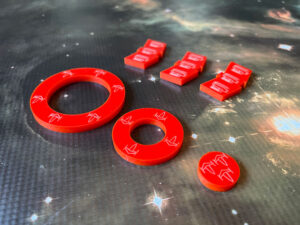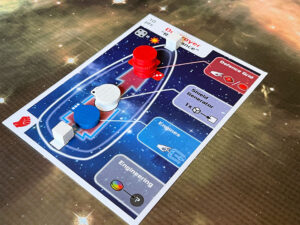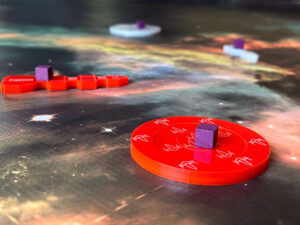 One of the great things about Kickstarter is that it brings games to life that you’d never expect. Ten years ago, if you walked up to a publisher with a sell sheet about a game where you flick dice off plastic ships, they might have laughed you out of their stuffy, smoke and whiskey filled conference room (probably).
One of the great things about Kickstarter is that it brings games to life that you’d never expect. Ten years ago, if you walked up to a publisher with a sell sheet about a game where you flick dice off plastic ships, they might have laughed you out of their stuffy, smoke and whiskey filled conference room (probably).
But thanks to the magic of crowdfunding, and the imagination of Jackson Pope and Paul Willcox, we have Flickfleet to entertain us. These are two guys with an idea, literally making a game in their garage to send out to happy gamers. So crack your knuckles and warm up your flickin’ fingers as we take a look at this unique skirmish game.
Gameplay Overview:
Flickfleet is a two-player skirmish game that will have two fleets of ships facing off against each other in a game of dexterity-based combat. You can either build your fleet using a point-buy system or use one of the game’s preset scenarios.

Once your fleets are assembled, learning the game is relatively simple. On your turn, you choose a ship that hasn’t activated yet this round and take two actions with it. The actions need to be different, and your options change whether you are activating a fighter or a capital ship.
Fighters, more accurately called Wings, come in two flavors: Fighters and Bombers, but both work pretty similarly. On a turn, you can move and fire with them. To move, you just flick them across the table. To shoot, you put a die (d10 for fighters, d6 for bombers) on the ship and flick it at another ship. If it hits it, you do damage. However, if the die careens out of the play area, it’s considered a miss, so precision is key.
Hitting another fighter removes one of its pieces. A fighter can fire as may times as it has pieces, so it starts with 3 shots per activation, and as it loses parts, that number drops. Capital ships have specific systems that determine what they can do. For example, a Carrier might fire its gun, recharge its shields, or launch its bomber wing. But as systems take damage, the options degrade. For example, once the defense grid has lost all its tokens, it can’t shoot anymore!
The goal, of course, is to obliterate your opponent’s fleet.

Game Experience:
Flickfleet was a game I expected to play a couple of times and move on. Visually, it looks “OK” and I wasn’t too excited when a review copy arrived on my doorstep. I tend to prefer games with a bit more in the way of production values. But hey, I love dexterity games, so I figured I’d go in with a mostly open mind.
But I have to say, I’m in love with this hidden gem. Not since Seal Team Flix have I been this impressed with a dexterity game. I think Flickfleet is one of those games that you just need to experience to really understand how much fun it is.

Learning how to play is actually really easy. Flick a ship to move it, flick a die to fire a gun. Hit something with the die you flick, and you hit. Yet hidden in that devilishly simple ruleset is a number of wrinkles that just make the game so incredible. I love how the fighters lose pieces as they take damage. This not only gives them fewer shots to fire (representing lost ships equaling lost firepower), but their profile shrinks, making them harder to hit. A lone fighter piece isn’t going to dish out too much damage, but can also become a buzzing fly annoying the enemy.
The two different dice the game uses also work on a few different levels. The d10, used by most ships, is actually a much worse die than the d6, used by the bombers and the Dreadnaught’s nukes for two reasons. One related to die shape and trajectory. Because the d10 is a cone shape, more often than not it will eventually curve off in an unintended direction, while the d6 will glide right towards its target. The other reason is for hitting ships. Once a capital ship’s shields are down, the number rolled actually matters. Whatever number comes up will damage that specific system. If the system is already damaged and has no more discs, the ship is reduced pieces. Yet the hit numbers are never greater than 6, meaning the d10 has a built-in 40% chance of missing a capital ship’s system even if you hit it with the die. Clever!

I don’t have a lot to complain about with Flickfleet, but if I had to pick a gripe, it would probably be with the ways shields are handled. While it takes one of your two actions to recharge a shield, it’s also an automatic success. This tends to draw out battles a bit more than I’d like as things can get a bit repetitive when you are down to your last ship or so. I almost wish it was a die roll instead of a straight-up recharge.
But other than that, I think Flickfleet is a really well-designed game. I can tell a lot of thought went into the design because even the movement rules make sense. For example, fighters can be flicked from anywhere, making them supremely maneuverable. However, bombers (and capital ships) have to be flicked from the back, you know, where their engines would be. This makes them handle really awkwardly. Especially the Dreadnaught, which is so big it moves like a garbage truck and seems to attract dice like a magnet. Contrast that with the destroyers, which are tiny and thin, making them much harder to hit. However, they are pretty much only good at shooting and can be obliterated by rolling a 4 once their shields are down.

Finally, Flickfleet’s intuitive ruleset makes it really easy to get to the table. In fact, my kids have been watching me play for a while and demanded to try. As they are only 5, I had to tweak the rules slightly. However, just using the fighter wings, and capital ships (without action points), they really got into it. I tell them they can flick their ship, and attack once for each piece the ship has (or disc for a capital ship). We just use the destroyers, bombers, and fighters for simplicity’s sake, but they are having a blast!
Final Thoughts:
I could probably gush on Flickfleet for a while, but I’ve gone on long enough. Every now and then an indie game comes along that just really impresses me, and I kick myself for not having tried it sooner. A few years ago it was Breakaway Football. Now it’s Flickfleet. I already found myself looking up expansions to see what else is available for this system. The game is fun, easy to get to the table, and battles are wrapped up in 20 minutes. Flickfleet clearly doesn’t take itself too seriously, but I can tell a lot of playtesting and thought went into its design. If you are a fan of dexterity games, this one is absolutely worth trying out.
Final Score: 4.5 Stars – A fantastic, dexterity-based skirmish game that just hits all the right notes.
 Hits:
Hits:
• Intuitive, easy-to-learn rules
• Quick playing games
• Clever dice system
• Addictive gameplay
Misses:
• Shield recharges can drag things at time.






















